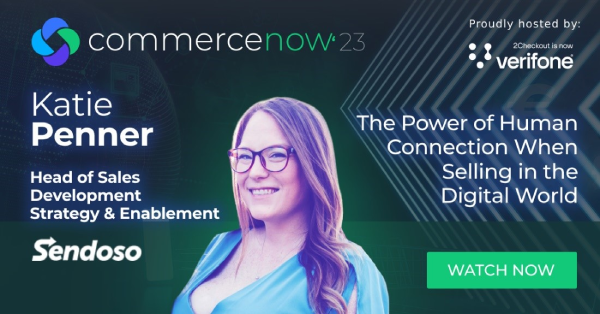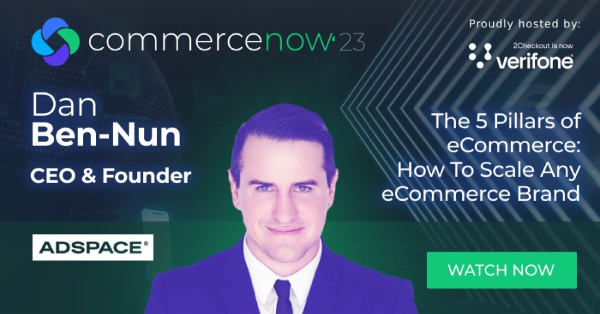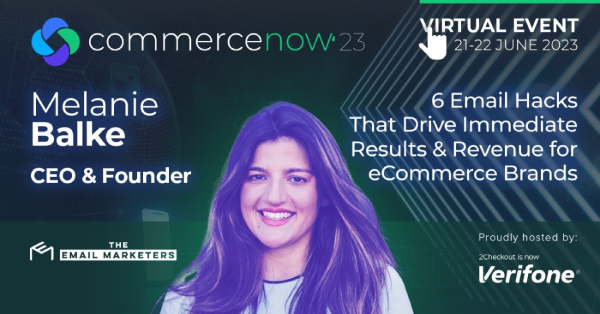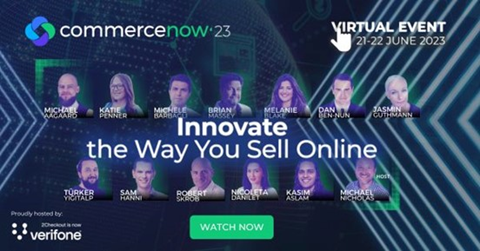The CommerceNow 2023 virtual event offered invaluable insights into online selling from industry experts Katie Penner, Dan Ben-Nu, and Melanie Balke. They discussed the importance of human connection, a 5-pillar framework for eCommerce growth, and effective email hacks.
Their shared insights provide actionable takeaways you can leverage in your business today to enhance customer engagement, increase LTV, and boost lead generation.
The Importance of Genuine Human Connections For Business Growth
In today’s cluttered digital landscape, buyers are bombarded with an average of 121 emails, calls, DMs, and meetings daily – so, what does it take to get noticed?
In her session, “The Power of Human Connection When Selling in the Digital World”, Katie Penner, Head of Sales Development Strategy & Enablement at Sendoso, highlights the power of authentic human connection in enhancing engagement and customer loyalty. She suggests that balancing technology and empathy can help create a more meaningful customer experience.
It’s simple: people buy from people. Knowing your customer’s needs, actively listening to their concerns, and showing interest in their stories can build trust and rapport. Sales should be viewed as partnerships focusing on building relationships – not just getting to a close.
Coupled with CRM systems, automation, and AI, you can streamline processes, gather insights, and personalize communication to create a more memorable experience for your prospects.
So, how do we do that? Katie recommends using a sending strategy.
How to Build a Solid Sending Strategy
A well-executed sending strategy captures attention and deepens customer relationships; additionally, it helps:
- Grow demand for your business and increase revenue;
- Give you a competitive edge;
- Create better customer experiences.
However, before sending anything, figuring out who you’re trying to reach is crucial.
Step into your customer’s shoes and try to see their needs and pain points. Katie recommends using social media as a starting point for your research. Done well, it will help you in more effective gift-giving.
Some gifting strategies include:
- B2B: Gift-giving varies by sales funnel stage: Pre-Demo (eGifts), Post-Demo (Personalized Items), Validation (Company Swag), and Close (Celebratory gifts).
- B2C: Use referral programs, social media contests, and customer surveys to reward and engage customers.
Gift-giving can be a delicate matter, but a well-thought-out sending strategy for your business can help create more impactful human connections – turning those interactions into thriving partnerships.
A successful example of this is:
Chewy.com: Sending Strategy Case Study
With 22.5 million monthly users, Chewy is the most visited pet food and supplies site globally, outpacing the competition because of its unique customer-centric approach.
In 2022 alone, Chewy sent enough birthday cards to their customers to stretch the distance between Dallas and New York (1,547.9 miles!). On top of that, they also provide 24/7 support & satisfaction guarantees on all their products.
But what truly makes Chewy stand out are the actions they take for their customers when their pets pass away, from sympathy bouquets and pet remembrance portraits to a complete refund on all unused bags of food.
Additionally, customers can donate their food to local pet shelters in their pet’s honor.
This level of empathy and thoughtful gifts allowed Chewy to build consumers for life. The value of their customer-centric approach led to a 306% higher lifetime value (LTV) and increased rate of recommendations from 45% to 71%.
Looking to discover more actionable strategies to elevate your eCommerce sales game? Then make sure to watch Katie’s full session here.
How to Scale Any eCommerce Brand
During his talk, “The 5 Pillars of eCommerce: How to Scale Any eCommerce Brand”, Dan Ben-Nun, Founder and CEO of Adspace, focused on core questions every brand should consider when trying to grow their eCommerce business.
- Does my product fit a target market?
- How well does my website currently convert incoming leads?
- How do I currently acquire customers?
- Am I building LTV for newly acquired customers?
- Am I keeping track of performance across all my company channels?
To help you find the answers to these questions, Dan recommends his 5-pillar framework for scalable growth.
Pillar One: Product Market Fit
This is the cornerstone of any successful eCommerce venture. Brands often fail to ask the simple question: “Does my product fit into a target market that is both high in demand and low in supply?”
Not addressing product-market fit means you run the risk of selling a product that nobody wants – and no amount of marketing budget can fix that.
Unfortunately, companies often default to spending more on marketing than the root issues.
The best way to start researching product market fit is by:
- Learning more about your industry’s current market dynamics;
- Exploring recent news & trends in the field;
- Conducting competitor analysis and checking their fastest-growing products.
Then, test your market hypothesis with a Minimum Viable Product (MVP) and gather customer feedback.
However, be careful not to overwhelm users with 48-question surveys or drawn-out questionnaires – no one wants to do those.
Simply ask respondents to rate the likelihood of recommending your company, product, or service to a friend or colleague – this will help you track your Net Promoter Score (NPS), a vital marketing research metric.
Benchmarks to Track Product Market Fit
- Aim for a customer return rate of 20-30% each month (anything higher suggests problems with your customer acquisition pipeline.)
- Maintain an even split of traffic from organic and paid channels.
Pillar Two: Website User Experience
Your website’s site experience is the engine that drives conversions – but your brand’s user experience (UX) extends beyond just the UI layout. Every aspect of your campaign, from ad creatives to budgeting, must be dialed in.
The better the total user experience, the more likely customers will convert.
Some actionable tips to improve UX:
- Merchandising: Showcase best-selling products prominently. Just like how Walmart puts their pop and candy near checkouts to increase the chances of a pickup.
- Analyze well-known brands: Bigger companies invest millions of dollars into their websites. Learn from their efforts, but always add your twist.
- Stay updated: Keep up with modern design trends; nothing kills conversation like an outdated website.
Benchmarks to Track Site Performance
- Target a conversion rate of at least 7% (2.5% is the average).
- Maintain an average bounce rate of less than 40%.
- Aim for an average session duration of around 3.5 minutes.
Pillar Three: Acquisition
Customer acquisition isn’t just about bringing in new faces; it’s about understanding which channels are most effective for doing so and what your Return on Investment (ROI) is for each channel.
To acquire customers, focus on effective channels with high ROI and use a mix of digital marketing. Don’t put your eggs in one basket – expand your customer channels with a balance of paid and organic outreach and track attribution to gain insight into audience behavior.
Understanding the Paid vs. Organic Balance
- Paid: Expensive but provides immediate results (i.e., Google ads, Facebook ads, etc.)
- Organic: Less expensive but takes longer to see results (SEO, content marketing, etc.)
Benchmarks to Analyze Your Acquisition
- Maintain an average cost per action (CPA) of $45 across all channels.
- Aim for a 300% return on ad spend.
- Push for an order value of above $125.
Pillar Four: Lifecycle
Research has consistently shown that retaining existing customers is far more cost-effective and profitable than acquiring new ones. If your customers make a one-time purchase and then vanish, you’re not maximizing the investment made to acquire them in the first place.
The most successful brands, the ones we all know and love, excel at customer retention. The strategy here involves a blend of customer research for effective segmentation, innovative product development to keep the offerings fresh, and targeted communication through email and SMS.
By combining these elements, you not only keep your customers engaged but also set the stage for upselling and cross-selling opportunities, thereby increasing the lifetime value of each customer.
Pillar Five: Reporting & Analytics
Last but certainly not least, reporting and analytics are the backbone of all your eCommerce efforts. This often-overlooked pillar is vital for cross-pillar optimization. Without accurate reporting and insightful analytics, you’re essentially sailing a ship without a compass.
Dan recommends creating an automated reporting where daily, monthly, and quarterly updates can be compiled and sent to you. This provides you with a clear understanding of your KPIs and your progress towards achieving them.
Get more tips on how to scale your eCommerce brand by watching Dan’s full session here.
6 Email Hacks That Drive Results for eCommerce Brands
Melanie Balke, CEO and Founder of The Email Marketers, dispels the myth that “email is dead,“, in her presentation “5 Email Hacks That Drive Immediate Results & Revenue for eCommerce Brands” highlighting its effectiveness for engagement and cost-efficient lead conversion.
She argues that the whole email lifecycle starts at the popup—how you get people onto your email list in the first place. And this, surprisingly, is where most brands trip up.
Email Hack #1: Email Capture
The popup is where the entire customer journey begins, yet few companies try to optimize it. Start with the forgotten secret to successful email marketing – A/B testing.
Melanie has some eye-opening stats to back this up. Switching a popup offer from 10% to a flat $10 off increased conversion from 1.6% to 8.7%. This simple A/B test saved an average of $2.20 per order, or nearly $60,000 annually, but also increased the amount of orders from these subscribers.
Why does this work? Our brains are hardwired to minimize effort, including mental calculations. The less math customers have to do, the higher the likelihood of conversion.
Pro tip: If you’re still offering free shipping as a popup incentive, stop. According to Melanie, free shipping should be a given, baked into the pricing of your products. Not only do people love free things, but free shipping can boost your average order value by as much as 90%.
So, if you’re not A/B testing your popups, you’re leaving money on the table. In Melanie’s words, “One small change had a huge effect.”
Email Hack #2: The Abandoned Cart Flash Sale Email
Let’s be honest: people have figured out the typical abandoned cart email flow. They know when to expect the discount and have become desensitized to the usual messaging.
Melanie suggests adding an extra email to your abandoned cart sequence that mimics a flash sale to combat this. Why? It all boils down to one word: Scarcity. People are more likely to act when something is scarce, be it in terms of time or quantity.
Apple has built its empire on this principle, creating a sense of urgency around new releases. Additionally, people are drawn to exclusive items and limited edition drops – knowing this psychological trick will enable you to use scarcity tactically to trigger user action and drive business growth.
Email Hack #3: The Quiz Email
Quizzes can serve two functions in email marketing: guiding customers to suitable products and profiling customers for targeted marketing.
- Product Recommendations: A quiz can simplify a purchasing decision. For example, if you sell multiple flavors of olive oil, a simple quiz like “What’s your favorite movie night snack?” can guide customers toward a particular flavor.
- Customer Profiling: If someone has visited your site but hasn’t looked at a specific product, a quiz can serve as an interactive and engaging way to nudge them toward a purchase. For instance, if someone has browsed your collection of movie T-shirts but hasn’t clicked on any, you could send them a quiz asking for their favorite ’80s movie and then recommend a T-shirt based on that.
Email Hack #4: 12 Days of Christmas (or Spring, Summer…)
Keep customers engaged with 12-day email campaigns featuring different products. This introduces unpredictability and urgency, encouraging daily interactions even if a purchase isn’t immediate.
These campaigns leverage the psychology of variable rewards. Because customers don’t know what tomorrow’s offer will be, they’re more inclined to engage with the campaign daily—even if they’re not initially interested in purchasing.
You can elevate this strategy by adding an element of surprise to the discount itself. Provide “mystery discounts—15%, 20%, or 30% off–– that customers can enter at checkout. This pushes customers closer to the end of the purchase cycle and plays with their curiosity, making them more likely to complete the purchase.
Email Hack #5: The Re-Engagement Giveaway
Every brand has a segment of subscribers who no longer engage with their emails. These people don’t open or click on multiple campaigns and may have ignored previous re-engagement efforts.
This “dead segment” can bloat your list and dilute your email metrics.
But before purging, try a re-engagement email with a compelling free offer. Even a tiny percentage of re-engaged subscribers is a win.
Melanie emphasizes the importance of making second-time purchasers feel valued to incentivize them for further engagement. For example, your email could read: “Hey, there’s a surprise in your next order”, then in the follow-up email, you could write, “Hey, one more order, and you’ll be part of our VIP group and gain access to our exclusive Facebook group”.
These types of emails make your customers feel appreciated and keep them coming back for more.
Email Hack #6: Unsubscribe Page Discount
In this final hack, Melanie tackles a topic that might initially seem counterintuitive: how to make the most out of unsubscribers. Contrary to popular belief, unsubscribing doesn’t necessarily mean a lost customer.
Many people unsubscribe from email lists for a variety of reasons. Maybe they’re overwhelmed by a cluttered inbox, or your emails aren’t relevant to them. Whatever the reason, unsubscribing doesn’t always correlate to a lack of interest in your product.
Melanie recommends making a last-ditch effort to turn unsubscribers into buyers by offering them a special discount on your unsubscribe page. You can frame it as a “parting gift,” a final offer before they go their separate way.
A good deal is hard to pass up. By offering a substantial discount, you tap into the subscriber’s potential lingering interest in your brand and make them reconsider their decision to disengage completely. Even if they still decide to unsubscribe, you’ve created a final opportunity for conversion.
Don’t miss Melanie’s full session as she reveals six transformative strategies that have delivered immediate results for her eCommerce clients.
Wrap-Up: Turning Insights into Action
The foundation of a successful eCommerce business stands on top of strong customer-brand relationships.
Coupled with effective email tactics and eCommerce growth strategies, your business will have all the tools and skills needed to succeed in the ever-evolving world of online commerce.
Tap into the vast knowledge and experience shared by Katie, Dan, Melanie, and other speakers to discover how to elevate the way you sell online. Be sure to watch all the CommerceNow’23 sessions here.
- SEO Powered Content & PR Distribution. Get Amplified Today.
- PlatoData.Network Vertical Generative Ai. Empower Yourself. Access Here.
- PlatoAiStream. Web3 Intelligence. Knowledge Amplified. Access Here.
- PlatoESG. Automotive / EVs, Carbon, CleanTech, Energy, Environment, Solar, Waste Management. Access Here.
- PlatoHealth. Biotech and Clinical Trials Intelligence. Access Here.
- ChartPrime. Elevate your Trading Game with ChartPrime. Access Here.
- BlockOffsets. Modernizing Environmental Offset Ownership. Access Here.
- Source: https://blog.2checkout.com/boost-your-online-selling-from-zero-to-one-hundred-commercenow23/







